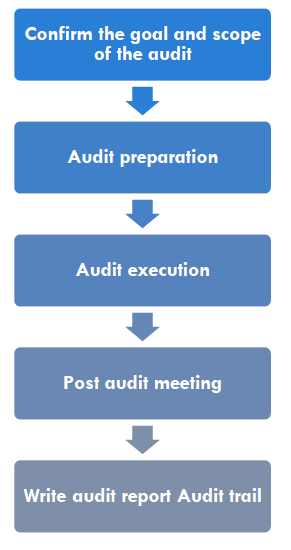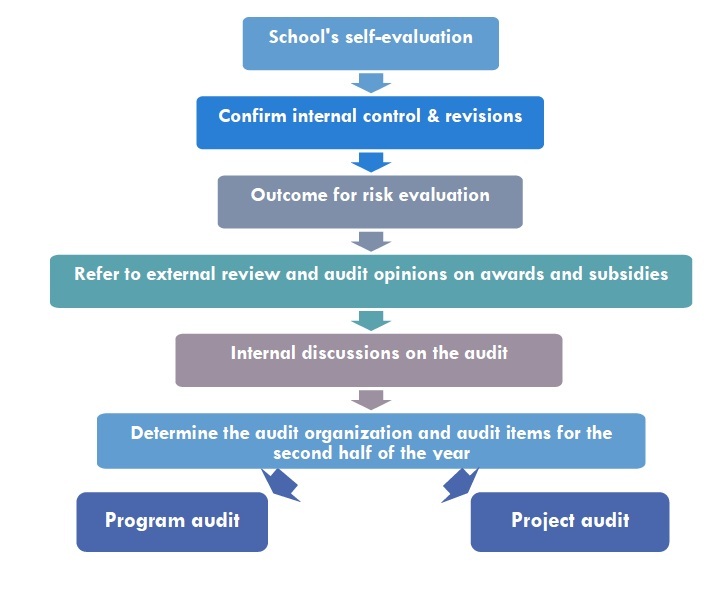Risk Management and Internal Audit/Control
University Risk Management
In recent years, globalization, declining birth rates, and rapidly changing industry structures have impacted university development, teaching strategies, and learning models. Cheng Shiu University conducts SWOT analyses based on factors such as geographical location, institutional scale, facilities, students, parents, faculty resources, administration, staff, community resources, industry trends, and social needs, combined with institutional research reports. This analysis guides the realization of the university’s vision and development goals. The university’s SWOT analysis is shown in the table below.
SWOT Analysis
Strengths● Diverse academic programs meeting the needs of learners at all educational stages.● Leading number of skills certification facilities among universities, effectively enhancing students’ practical skills. ● Faculty with strong professional and industry backgrounds; outstanding performance in industry outreach and income generation among private universities of technology. ● Campus counseling services recognized with multiple national awards in the higher education sector. ● Prime location with excellent surrounding facilities and abundant shared and collaborative resources. ● Strong educational performance, sound finances, and top results in Ministry of Education evaluations and inspections. ● Hosts internationally recognized centers, including the Environmental Toxins and Emerging Pollutants Research Center, the Cultural Heritage Restoration Center, and the Industry Elite Training Demonstration Base, fostering global engagement and cultivating advanced industry talent. |
Weaknesses● Declining average student entry qualifications with weaker fundamental academic skills.● “Low-motivation” generation lacking learning drive and self-exploration of interests. ● Part-time employment among students affecting the quality of learning in core professional courses. ● Need for improvement in students’ foreign language proficiency and global perspective. ● Higher proportion of senior faculty, leading to an unbalanced overall age structure. |
Opportunities
● In the AI era and rapidly evolving industries, demand is rising for interdisciplinary professionals with strong core expertise. ● Global net-zero carbon goals are driving corporate demand for green energy and low-carbon talent. ● Government actively promotes digital innovation, lifelong care, livable communities, the New Southbound Policy, and key industry initiatives, including expanding enrollment of overseas Chinese, Hong Kong, Macao, and international students. ● Kaohsiung is developing the Asia New Bay Area into a major economic and trade hub in southern Taiwan, attracting leading technology companies and increasing local talent demand, prompting enterprises to enhance talent retention and recruitment. ● The planned MRT Yellow Line station near the university will improve transportation convenience. |
Threats● Declining birth rates sharply reduce the school-age population, making student recruitment more challenging.● High density of universities and diverse options, coupled with a social preference for national universities, hinder recruitment of top students. ● Limited pool of high school and vocational graduates in southern Taiwan, with low willingness to study outside their home region. ● Insufficient international image of Taiwan’s technical and vocational education, making global exchanges and recruitment of top talent difficult. |
SO– Leveraging Strengths to Seize Opportunities• Integrate diverse academic programs with skills certification to create cross-disciplinary practical training environments in digital innovation, AI, IoT, and green energy, cultivating multi-skilled talent aligned with industry needs. • Align with global trends by providing teaching support to enhance faculty capabilities in AI applications, EMI instruction, and innovation & entrepreneurship, thereby improving teaching effectiveness. • Leverage institutional strengths to expand international recruitment, offering special programs to attract overseas Chinese and international students in line with the New Southbound Policy and hands-on talent demand. • Combine international research resources with geographical advantages to build a globalized campus and promote cross-border learning opportunities for students. • Strengthen alumni networks by inviting industry professionals among alumni to share experiences, fostering closer alignment between curriculum and industry practice.
ST– Leveraging Strengths to Mitigate Threats• In response to declining birth rates, integrate counseling networks, campus activities, scholarships, and government subsidies to reduce student burdens, enhance enrollment appeal, and stabilize student intake. • Build on the international collaboration foundations of the Environmental Toxins Research Center and the Cultural Heritage Restoration Center to foster cross-disciplinary teams and strengthen the global image of technical and vocational education.
WO– Seizing Opportunities to Overcome Weaknesses• Organize corporate visits and internships alongside liberal arts and sustainability courses, offering free language resources to boost learning motivation and global perspective. • In response to reshoring Taiwanese businesses and industry demands, collaborate with leading companies to launch specialized programs, promoting industry–academia co-education to increase learning incentives and reduce financial burdens. • Develop digital learning environments and a smart library to provide diverse self-learning resources, enhancing student engagement and flexible learning opportunities.
WT– Reducing Weaknesses and Mitigating Threats• Strengthen general education foundations (Chinese, Physics, English, Computational Thinking) through a tutor system and learning communities to guide self-directed learning, increasing motivation and sense of achievement. • Establish faculty overseas training mechanisms to promote international academic collaboration, introduce innovative teaching methods, enhance the university’s global reputation, and attract outstanding students. • Advance smart campus initiatives and green campus development to create a friendly, modern learning environment, improving institutional image and enrollment competitiveness.
|
Risk Management Process and Operations
To address risks arising from trends in education policy, social competitiveness, and internationalization, the university follows the Ministry of Education’s Risk Management Implementation Guidelines, integrating risk management into daily operations and decision-making. When setting institutional development goals and strategies, potential risks affecting goal achievement are identified and assessed, with internal control mechanisms applied to reasonably ensure the attainment of these goals.

Internal Control and Audit
To ensure operational efficiency, asset security, and reliability of financial reporting, the university has established the Internal Control System of Cheng Shiu University, implemented upon Board approval. This system covers procedures for personnel, finance, Board and Supervisor operations, internal control points, and audit regulations.
The Audit Office develops annual internal audit plans and special audit schedules based on risk assessments, updates to the internal control system, execution priorities, and audit team experience. In 2024, the university released the 2023 Internal Audit Report, covering 97 items, with a 100% compliance rate. Of these, 7 items were not applicable, 97 were compliant, and none were non-compliant.
Annual Audit Planning Process

Internal Audit Execution Flowchart

University Suggestion System and Reporting Mechanism
Faculty, staff, and students can submit feedback through the University Suggestion System to ensure opinions are effectively communicated and appropriately addressed. The Student Association also operates a Student Rights Department platform as an additional channel for student feedback. The system keeps the submitter’s identity fully confidential, automatically sending anonymous emails to authorized responders in the relevant unit. All units must reply within seven days.
Each unit designates at least one person to handle and respond to suggestions. The Secretariat regularly reviews the handling status, follows up by phone with units that have not responded within seven days, and continues tracking until completion. In Academic Year 2023, 162 suggestions were received, mainly related to “systems and equipment,” “curriculum and teaching,” and “campus safety and environment,” with no major whistleblowing cases reported.
Statistics on the Number of School Affairs Suggestions
|
Academic year |
Administrative unit |
Academic Units |
Private Messages |
Total |
|
2020 |
87 |
9 |
11 |
107 |
|
2021 |
57 |
6 |
6 |
69 |
|
2022 |
44 |
5 |
6 |
55 |
|
2023 |
138 |
21 |
5 |
162 |

